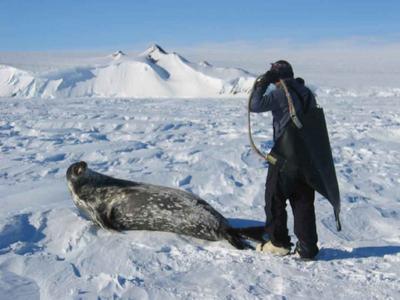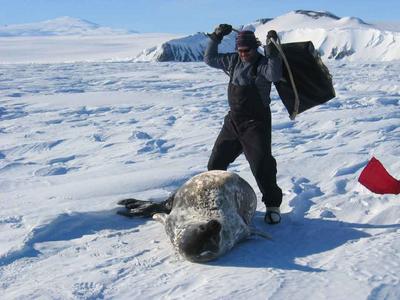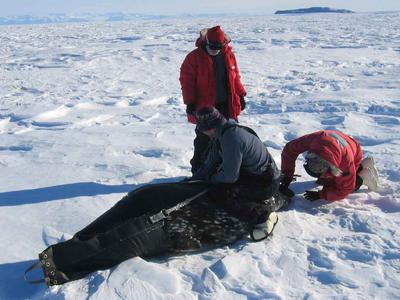
|
|
20 October, 2003
After yesterday's low visibility and high winds, today was an amazing
day. We began, once again, with some incredible gusts of wind-the
huts were rocking in the breeze. It was, however, a beautiful clear
morning and it was certain that, without the wind it would be
beautiful. So we did what any good field-based researchers would
do-dawdle over coffee, cook a big breakfast, and wait for things to
change. Lo and behold, by the time the last breakfast dish was
washed and put away, and the thermoses filled with hot water for our
lunch packs, the wind died. We quickly changed from hut wear to
field clothes-a difference of at least 3 layers top and bottom-and
got ready to go.
Today we surveyed the southern half of our study area, starting at
South Base and finishing at Pram Point (don't forget to check the
study area map from 10-17 if you're confused). We traveled south on
the relatively smooth sea ice road until it was necessary to cut east
across the usual 4-wheel drive snowmobile terrain to reach South
Base. South Base is at the southern side of the Erebus Glacier
Tongue, and is an area with icy cliffs, snow-covered valleys, and a
persistent crack in the sea ice. Today, however, there were no seals
taking advantage of that crack.
From there, we followed the coastline to Turtle Rock (guess what it
looks like), and then to the Hutton Cliffs to check on seal activity.
Each time we saw a seal or group of seals we would stop and check to
see if the adults were already tagged or if they had broken tags that
needed to be replaced. We tagged 5 live pups today and 2 dead ones.
We have now tagged 12 live pups and 6 dead ones. It's fairly obvious
why we would tag live pups, but why tag dead ones? In a population
study such as this, it is important to look at survival rates. Data
must be collected about the number of seals who make it from birth to
adulthood, but it is equally important to account for those that
don't. In addition, it is important to tag all dead seals (pup or
adult) just to make sure you have counted every seal.
I tried my hand, once again, at the seal bag dance. This time, after
a few half-hearted throws, I decided to act with a bit more
commitment, instead of tossing the bag and silently hoping I just
might miss so I wouldn't have to find out what riding a 1000 lb. seal
is really like. I lunged heartily and, miracle of miracles, the bag
ended up over the seal's head. Then the fun began as I gripped the
side ropes tightly, straddled the seal, and tried to anticipate the
bucking and rolling that was coming-sort of like riding a bucking
bronco. I'm not sure who was breathing more heavily, the seal or
me. We came to an understanding, and the seal lay still long enough
to receive its tags. Afterward I realized I should have paid closer
attention at our local rodeos to see how the pros do it!
Our southern tour ended at Pram Point, near New Zealand's Scott Base.
Last week, when Gillian, Darren, and Brent did an aerial survey by
helicopter they saw one seal in that area. We surveyed a pressure
ridge and ice crack for any signs of that seal or others, and found
none. It was almost 6:30 and time to head home for a well-deserved
meal. The ride home on the packed road took about 30 minutes-and
seemed much smoother than my initial ride from McMurdo on the sea ice
road last Thursday.
When we got back to camp, the phone setup folks were here installing
our phone line. Our phone works via a VHF radio relay back to
McMurdo. I suppose it's just another piece of amazing Antarctic
technology. Once all the bugs are out of the system, we'll also have
internet access from the camp. Until then, I'll be saving up
journals to send in a frenzy each time I come to McMurdo.
Daily Haiku:
We go seeking seals
Lounging near the open cracks
Feeding their babies

Mark Johnston bagging a seal for tagging


I'm ready for another great day!

While Mark holds the seal, Kelly and Gillian place tags in her rear flippers.
Contact the TEA in the field at
.
If you cannot connect through your browser, copy the
TEA's e-mail address in the "To:" line of
your favorite e-mail package.
|
